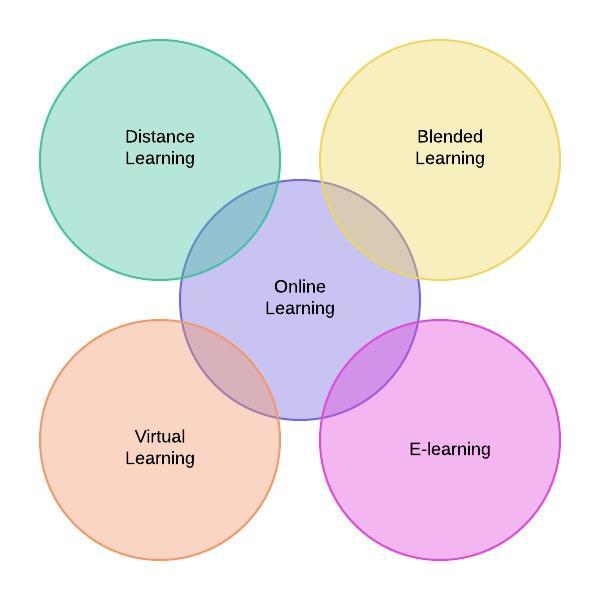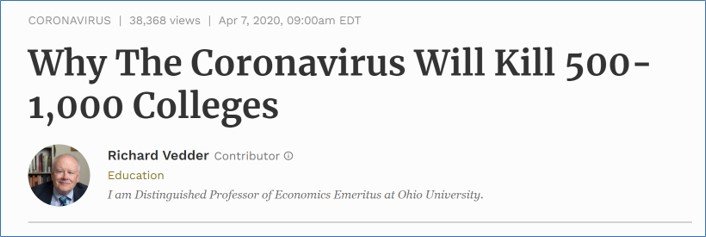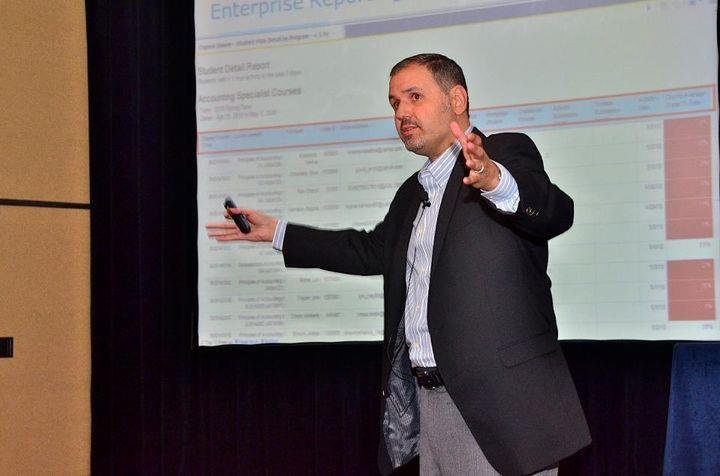A cheeky idiom is that an expert isn’t an expert until they live at least 50 miles away.
Well, at Campus, we have stacked the deck with experts on our Senior Management Team and we intend to leverage their strategic expertise! Just because we can walk down the hall and ask them questions, doesn’t make their answers any less important or worthy of attention.
This blog will be a brief interview with Dr. Jeff D. Borden (Chief Academic Officer at Campus, Executive Director of the Institute for Inter-Connected Education, 22-year professor of Education and Communication, and long-time Trend Spotter for Higher Ed). Throughout Jeff’s career, he has been (and still is) asked to give keynotes, workshops, plenary addresses, and consultations for some of the biggest schools around the globe. He is an expert on eLearning, holistic education, communication, and learning science. He has also been asked by several organizations to shine a light on the future of higher education for much of his career. Well, that light may be more important now than ever.
This interview will be broken into two sections – where does higher education sit today under the covid-19 context and what will things look like in 6-12 months?
Campus: Dr. Borden, you have been a “trend spotter” for years in higher ed…what does that mean?
Jeff: I have had the privilege and honor of being asked for my thoughts about the future of education for years. While I may not be quite as sought out as Dr. Bryan Alexander who is indeed a futurist or Jeff Selingo whose sole job has been as a reporter of higher education, or even Michael Feldstein and Phil Hill (eLiterate) who act as part watchdog and part filter for our sector, I not only follow those people (and more), but I am often asked to explain or expound upon their work. I have spoken to hundreds of audiences, while also having written blogs, annual predictions, and trend analysis for numerous organizations over 20 years. Obviously, the future of higher ed is more en vogue right now than my talks on teaching and learning, brain science, or eLearning…
Higher Ed’s Current Context (as of April 25, 2020)
Campus: As the world seeks to reopen “everyday” businesses and organizations, higher ed is dealing with a slightly different experience. They have largely remained open for business but under such abnormal circumstances, the product is not recognizable to some. How do you see the current landscape?

Campus: As the world seeks to reopen “everyday” businesses and organizations, higher ed is dealing with a slightly different experience. They have largely remained open for business but under such abnormal circumstances, the product is not recognizable to some. How do you see the current landscape?
Jeff: First, let me be clear about remote or “distance” learning. This is not a shift to full-on eLearning. Online learning, within the framework of how it has evolved over the past 20 years is not the same thing as what is happening right now. I have taught using most modalities since the late 90’s without a break and what we are seeing now is not online education. Emergency measures of moving fully face-to-face (F2F) classes to remote has seen a majority of professors just move to a video-conferencing solution or put up a “message board” style of classroom. That is not the same thing as a typical online class where the entire experience is set prior to the term start, the curricular and andragogical choices take full advantage of the modality, and there is an intentional eye toward the student’s (user’s) experience from the outset. As a result of that difference, we are already starting to see a lot of negative, “I told you so” pieces popping up from (mostly) liberal arts professors who believe online learning to be second-best (or worse) in the upcoming year. So to anyone making decisions about the student experience OR the cultural implications for an institution, know that the prevalent formula in current use is not optimal.
Campus: But the college experience as a whole is under siege right now, yes? Not just the classroom shift?
Jeff: Of course. Again, based on lessons learned in the early 2000’s, most schools that promoted a fully online experience at the time quickly realized that infrastructure for non-classroom-based activities was also crucial. Phone and email support just don’t cut it for students (and especially when adding in employees) who are working remotely. What is likely a shame is that the same technologies that can help under a fully-distant context, also greatly help a “normal” context too. But administrators don’t know what they don’t know, so those technologies are not only absent for many schools today, they are not even sought out during this crisis. I think back to the technologies and infrastructure we built when I was the Chief Innovation Officer at a university. Those tools like the shared whiteboard, the crowd sourced tutoring app, and the mobile / web-based portal tools were game changers for our fully online students but also for our fully on-campus population, including staff and faculty who leveraged one or both modalities. We studied their effect and saw a significant increase in retention, but also an impact on enrollment and even alumni affinity.
Campus: But those types of tools and the infrastructure they built took time to develop and connect. What have you seen regarding school’s abilities to be agile and incorporate them during this crisis?
Jeff: Well, honestly and quite unfortunately, it’s not a coincidence that higher ed is not really known for being agile. That lack of ability to adjust quickly and pivot effectively, especially as their customer pool (students) is concerned, is really hurting the sector right now. While it’s true that silos exist in almost every business, I don’t think it’s unfair to say that silos in educational organizations are a both deeper and promote more dysfunction than most. And that dysfunction is on display right now, for all to see. It’s really hurting a lot of schools, a lot of students, and will likely lead to a major acceleration in college mergers and/or closures for the next few years. The obvious disconnect between IT and the academic / student affairs side(s) of the house is really apparent right now. There has been so little communication and strategic thinking between CIOs and CAOs historically that the current conditions requiring radical transparency and coordinated thinking are akin to a moonshot at some institutions.
Campus: So what would radical transparency and coordinated thinking do for schools right now?

Jeff: Most models I have seen point to a 20% reduction in college / university enrollments for Fall, across the board. Even some less-credible (or perhaps better stated as less-transparent) models still show a decrease of 10-12% in student enrollments for Fall of 2020. That is in addition to the immediate loss of money (both revenue and other monies) due to reimbursements of everything from housing to tuition from this Spring. While many schools have remained open, almost all schools have furloughed at least some employees (faculty, staff, adjuncts, etc) along the way. Because a number of institutional cultures have poo-poo’d eLearning for a long time, there is a tremendous under preparedness, but also a huge bias against the modality. What was once a loud and proud statement from a President (“We will NEVER use online learning at our institution!”), is now an embarrassing point most hope is not uncovered. And it led to tremendous bias not only for faculty, but also for staff, students, and parents who believed the original message that eLearning was “second best” (at best). We’re seeing parents and students advocate for tuition reduction due to the “lesser” nature of eLearning, even seeing some schools cut the pay of instructors based on some bizarre model of teaching time, suggesting that facilitating a powerful online class should not leverage the power of the web, but instead remain a one-to-one-to-one experience. At the same time, faculty are learning that quality, online instruction likely takes more time (at least initially) to develop, and staff realize they can’t answer questions for students. Meanwhile, the deep silos, coupled with processes that are not efficient nor customer-centric, become painfully obvious as the common tactic of “throwing people at problems” is far less helpful remotely.
All of those problems, inefficiencies, and yes, the silos could have been worked on through a marriage of infrastructure as well as operations (IT and the ‘business’ side of the house). But at many schools, we are seeing IT shops that are typically treated as a transactional support arm being called on to act strategically, while academics and student affairs groups who are often used to making any decision(s) they want regarding technology without any concern for how those choices impact interoperability or scalability are in desperate need of cohesion. Throw training into the mix, which is usually handled by yet another group at many institutions and which is also often a group without much respect, and you get a perfect storm during this crisis. There are answers out there – answers that could fundamentally improve a school’s business continuity – but it’s the wild west regarding how to find and especially how to design such solutions.
Campus: So what are the best schools doing that change the variables in the equation you have laid out here? How can an institution help make all of this work for them instead of working against them?
Higher Ed’s Near-Term Context (School Year ’20-21)
Jeff: From my perspective this is about order of operations. Honestly, the academy should really rely on math, models, and management, even though it’s easy to fall into a reaction-centric framework. But as an “innovation” guy throughout my career, I must admit, this should also be about looking for opportunities to adjust / correct problems too. At least the savviest of leaders will seek to do that.
Campus: So what does that look like? Math, models, and management?
Jeff: Well, for math and models it means looking at stats, capabilities, etc.. Just like the country should be doing right now, we should open up certain sectors based on contribution to the economy AS we also monitor (closely) infrastructure. So, like Israel or Sweden, we should send specific sectors back to work as they impact the economy and we should watch hospitals for capacity. This would allow the country to throttle up and down the amount of people involved in the culture, with variables like masks or social distancing and especially testing (both viral and anti-body) filtering into the algorithm as they are available. But again, we don’t see this kind of direction nor do we see this kind of leadership right now. Instead it’s the wild west. But college and university leaders should likely enact this same strategy anyway, standing above the fray and using the tools higher education has been promoting for centuries.
Campus: But how can an institution work “beyond” the decisions made by the government?

Campus: But how can an institution work “beyond” the decisions made by the government?
Jeff: Yes, I’m getting to that. First, it means that school leaders need to look beyond what unfortunately becomes a political issue instead of a math or even a community issue. I like Bryan Alexander’s three-tree approach to what our next 12-18 months will bring. One of three scenarios is likely to happen this Fall. 1) Everything will go back to normal with students seeing they can attend colleges (in-person) starting in August or possibly later in September. 2) We will see another total shut-down at some point in the late Summer or early Fall, meaning everyone will be asked to self-quarantine yet again, also seeing most higher education take place at a distance for Fall and likely Spring. 3) We will see an “ebb and flow” between sheltering-at-home and completely immersing ourselves back into normalcy. As hot spots emerge, governments will tighten the reigns in an attempt to quarantine only the impacted community.
So what should leaders do with that? Well, some leaders will attempt to determine which of the above scenarios is most likely and strategize their plan from there. It’s a fair idea, essentially taking some later-variables off the table and proceeding with a plan now. (Of course, unless the plan relies on something that does not happen…)
Some leaders will be more reactive, waiting for government officials and community leaders to help direct strategy. This will obviously make budgeting very difficult.
But beyond all of this, there are likely more steps that savvy academic leaders can and should take.
What I mean by that is specific to senior level cabinet meetings likely performing more strategic level setting, role setting, and should see Presidents and Provosts “forcing” their senior leaders (if necessary) to start working in ways many are unaccustomed to working. This is not the time for a solution or strategy to be dismissed by one VP simply because it was thought up by another VP. This is not the time for territoriality. This is not the time for holding cards close to the vest. If leadership needs to use an analogy of wartime decision making, so be it. But whatever framework is used, it’s time to work together, while also working in ways that may be both unorthodox and potentially even uncomfortable.
Similarly, academic leaders should be using modeling to determine enrollment / admissions options, current student retention numbers, and potentially taking advantage of a desire by some members of society who wish to use this opportunity to train, re-train, or find a new path to success. This may be the first recession in 100 years where higher ed does not see a bump in enrollments, but that does not mean there aren’t some opportunities out there. Then, based on those numbers, and here is the really hard part, the institution should start to look at how many staff, faculty, and administrators it takes to serve such a population. Here is the Yin and Yang of having so many adjuncts. On the one hand, many of those adjunct faculty rely on classes to make ends meet, but on the other hand, teaching is driven only by demand. It is obviously a much, much harder conversation when looking at staff. But to my earlier point about opportunism, as a major area for improvement across higher ed has been taking care of “bloat”, the issue may be forced right now.

At the same time, academics should be leaning on senior IT leaders, explaining needs, outcomes, outputs, and more, while IT leaders should be looking at systems as a portfolio of services and not as kingdom generators. The most seasoned academics at an institution need to truly embrace the “whatever it takes” model for their students and their institution’s ability to succeed, leading the way in flexibility, agility, and more. In fact, I predict a number of papers to emerge in the coming months about the importance of teaching and learning beyond the cognitive. Seven (or more) decades of research showcasing the importance of strategically educating with affective and conative treatments will be on display during this time of remote classrooms. In the end, that could be an incredibly powerful thing for education as holistic teaching and learning across a student’s entire context would help millions of students every year, not just during a pandemic.
Campus: So what’s next? What should leaders be doing now?
Jeff: Well, over the next few weeks, most schools are myopically focused on how to replicate some kind of meaningful graduation ceremony. I would imagine platforms like Shindig are doing some good work to help people replicate big events.
But as soon as the Spring term is done, most schools should likely have some very strategic working sessions, including many more constituents than they normally do. Lean on the knowledge, creativity, and innovation that already exists within the organization.
At the same time, as those strategic conversations are happening for Fall / Spring, beef up the infrastructure. Again, as I noted earlier, do so collaboratively and collectively, but do it. Obviously, I am predisposed to recommend a solution like ours which is an incredibly aligned fit for circumstances like we find ourselves in today. But most schools are likely in need of a good overhaul of existing infrastructure that does not lend itself to moving forward, meaning removal of some old, outdated systems and the introduction of some new, modern tools. If schools work on this across multiple departments, outcomes, and needs, it may actually be the glue that helps bind some schools together.
Campus: Thank you Dr. Borden for your thoughts and insights.
Jeff: It’s my pleasure. I hope people stay safe, first and foremost. But I also hope we find our way out of this experience stronger and more agile than ever before. Good luck and good learning.
